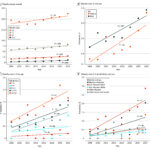In a remarkable breakthrough, researchers at KAIST have unveiled a specialized gut-brain circuit that allows the brain to differentiate glucose from other nutrients absorbed in the digestive system. This discovery enriches our understanding of the intricate communication between the gut and the brain, offering promising avenues for addressing metabolic disorders such as obesity and diabetes.
The Study: A Collaborative Effort
On July 9, KAIST announced the findings from an international collaboration led by Professor Greg S.B. Suh of the Department of Biological Sciences. The team included Professor Young-Gyun Park, Professor Seung-Hee Lee, and researchers from Albert Einstein College of Medicine in New York. Together, they demonstrated that animals in a fasting state can recognize and prioritize glucose in the gut via a specialized neural pathway.
How Does the Brain Detect Glucose?
While the scientific community has long understood that the gut conveys caloric information to the brain to regulate appetite, this study goes further. It reveals a nutrient-specific pathway, showing that the brain can sense glucose independently of general caloric content. The researchers utilized cutting-edge techniques—including optogenetics, neural imaging, and targeted nutrient infusions—to uncover this phenomenon.
Their findings highlighted that specific CRF neurons in the paraventricular nucleus (PVN) of the hypothalamus respond selectively and rapidly when D-glucose is introduced into the small intestine. Interestingly, these neurons showed minimal or inverse responses to other nutrients, such as L-glucose, amino acids, or fats.
Mapping the Pathway
The team traced the glucose-sensing signals from the small intestine through the spinal cord to the dorsolateral parabrachial nucleus (PBNdl) in the brainstem, ultimately reaching CRF neurons in the PVN. This pathway contrasts with signals from amino acids and fats, which travel via the vagus nerve.
Functional Significance
To confirm the essential role of this circuit, researchers inhibited the CRF neurons in fasting mice. As a result, the mice lost their natural preference for glucose, underscoring the necessity of this pathway for glucose-specific nutrient selection.
Building on Prior Research
This study builds upon earlier investigations led by Professor Suh at NYU, where similar glucose-detecting neurons were identified in fruit flies. Inspired by these findings, the KAIST team sought to uncover analogous mechanisms in mammals.
Implications for Metabolic Health
Dr. Jineun Kim, Dr. Shinhye Kim, and Wongyo Jung, co-first authors of the study, emphasized the fundamental nature of their inquiry: “How does the brain distinguish glucose from other nutrients?” Their findings underscore the importance of spinal-based gut-brain circuits in maintaining energy balance and metabolic homeostasis.
Professor Suh remarked on the therapeutic potential of this discovery: “By identifying a specialized gut-brain pathway for glucose sensing, we open up new possibilities for treating metabolic diseases. Looking ahead, we aim to explore how similar circuits detect other vital nutrients and how these systems interact.”
Publication and Future Directions
The study, published in the prestigious journal Neuron on June 20, 2025, represents a significant step in understanding nutrient-specific brain signaling. Future research will likely delve deeper into the mechanisms underlying nutrient-specific pathways and their roles in health and disease.
This groundbreaking work not only highlights the sophistication of the gut-brain axis but also sets the stage for innovative approaches to managing metabolic disorders, offering hope for millions affected by obesity and diabetes worldwide.
Kim, J., et al. (2025). Encoding the glucose identity by discrete hypothalamic neurons via the gut-brain axis. Neuron. doi.org/10.1016/j.neuron.2025.05.024 IF: 15.0 Q1
